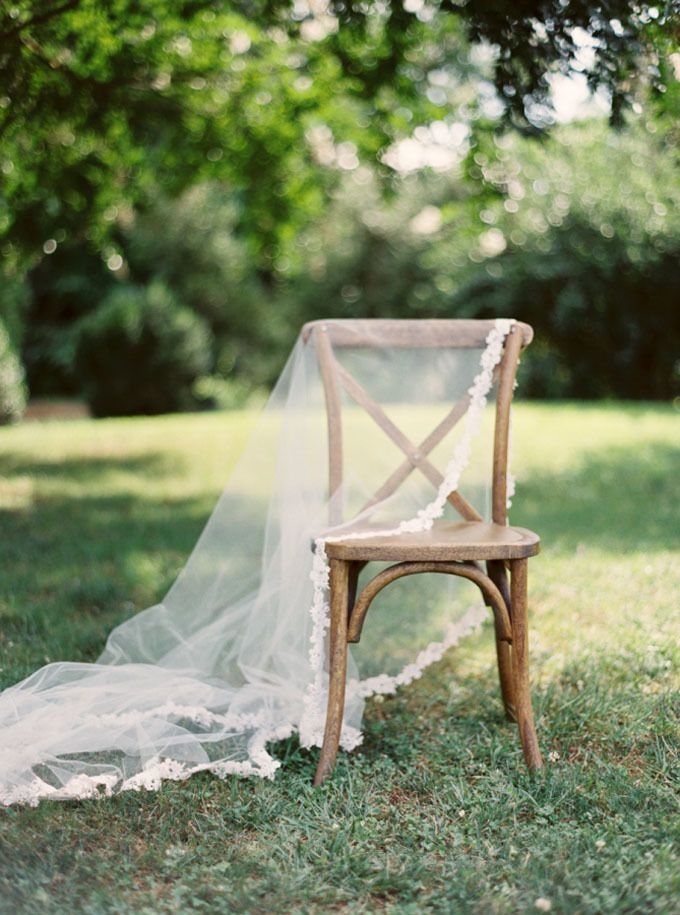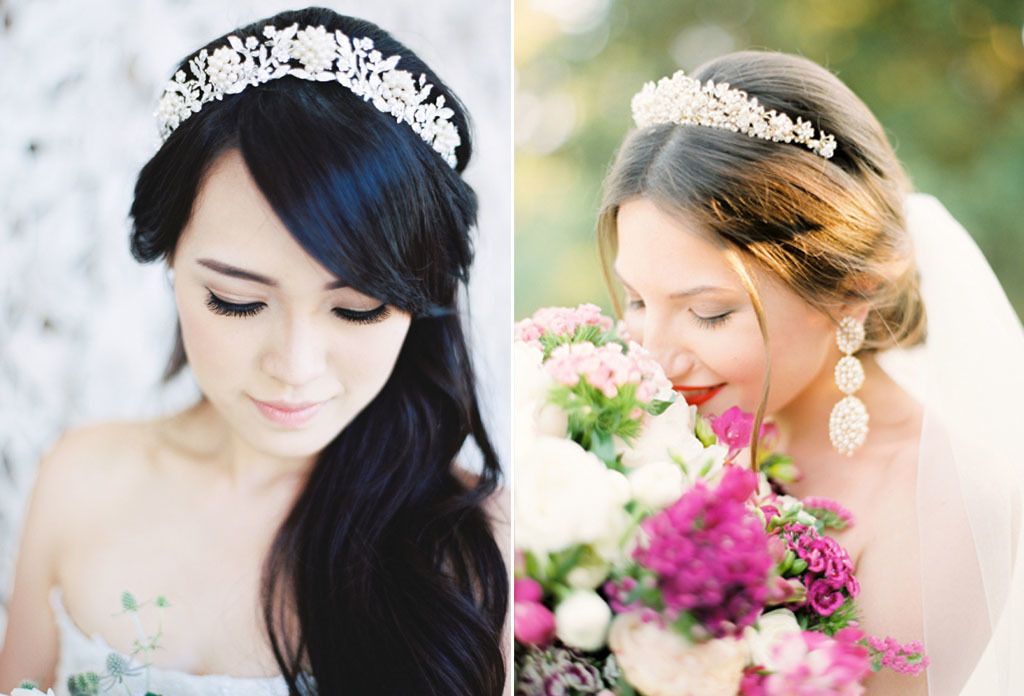
Photography: Sposto Photography
When it comes to wedding accessories, some brides have it all figured out. Some others, however, don't quite have it on their sleeves. The wide variety of wedding accessories available can be overwhelming, but you shouldn't decide to just skip them altogether. If you're not quite sure on which accessories you should choose for your own wedding, read on carefully to learn more about your options.
Why do I need bridal accessories?
Accessories are often seen as unnecessary details, but that doesn't have to be case. Bridal accessories add a touch of elegance that can enhance even the simplest wedding dress, and can connect your wedding outfit with your overall wedding theme. Just think of how a feather headpiece can complement a 1920s flapper look, or how a sparkly tiara perfectly suits a princess-inspired wedding gown.
Some bridal accessories started out as a tradition. A veil, for instance, has long been part of a tradition that symbolizes a bride's purity. These days, though, most brides forgo the symbolic meaning and focus more on the aesthetic values of accessories. At the end of the day, it all comes down to you. Feel free to go with anything that makes you feel beautiful and comfortable on your wedding day.
Which bridal accessories should I wear?
Among the many accessories a bride can choose to wear on her wedding day, we will focus on only a few popular ones today. We'll cover veils, headpieces, boleros, and gloves. Read on to get started.

VEIL
A veil is a piece of fabric a bride wears over her head. There are a few types of veils according to length, and each one comes with its own styling tip. Lately, a lot of brides have decided to ditch the veil entirely and walk into a wedding ceremony without one. Therefore, before we tell you more about all the veils you can choose, let's address one question:
Do I have to wear a wedding veil?
First and foremost, ask yourself if a wedding veil is really a must for you. Some people from the older generation might think so, and they would also argue about a veil being inappropriate for second-time weddings and pregnant brides. Consider whether these considerations are important to you before making any further decisions. You should also ask yourself, do you really want to wear a veil at all? It's a tradition, yes, but technically it's not absolutely necessary, meaning that you can still get married even without one. In the end, it all comes down to you. To veil or not to veil, it should be the bride's personal choice.
Wedding veil styles
If you've decided to wear a veil after all, let's get on to the fun part. As you may have noticed, veils come in different shapes, sizes, and materials. Based on length, there are a few types of veils. Scroll right down to see them.

Click
here to download the image
Different veils require different styling. We'll go over the styles one by one while also covering the perfect ways to these flowing beauties from the shortest to the longest.

First up is the birdcage veil. This veil comes with a short cover-up on the face with ranging lengths. Some cover down to the eyes, the nose, even the entire face. This veil matches really well with a vintage 1950s or 1960s feel. Wear a sheath dress with this veil and add some feathers or vintage brooches as accents. One thing you might want to consider is the fact that as the veil will come so close to your face, you might find it hard to blink especially if you're wearing fake lashes.
The flyaway veil is a wispy, multi-layered veil that falls over the shoulder at its longest. At its shortest, it usually falls behind the head. The flyaway would be so perfect for a more casual wedding, especially worn by a simple bride with a playful personality. A styling tip is to wear it with a short or sheath dress. Gowns without trains would also work well with this one. If you're short-haired, this veil would be placed wonderfully over your head. One with long locks? Create a simple, low-key hairdo and you'll be all set.

Now for medium-length veils, the elbow veil passes over the shoulder and floats along the upper arms, ending just above the elbow. This casual veil was a favorite in the 1950s. We love this length in that it's long enough to instill elegance, yet short enough to be practical. You can wear the veil with short casual dresses and with dresses with no trains or short trains. Long pencil sheath dresses would work best in our opinion. As for the hairdo, the versatile length works well with any type of hairstyle.
The fingertip veil stretches a bit longer down. It floats around you like a cape and extends as far as your outstretched fingertips. This veil was most popular in the 1940s and 1950s and was worn by Kate Middleton when she married Prince William. The fingertip veil complements any long dress but will not be suitable for petite brides as they can sink in the cape-like the veil. We also don't suggest wearing this veil at night, for its length will interfere with your activities, especially if you plan on dancing the night away.

The waltz veil, also known as the ballet veil, normally ends between the calf and the ankle. It's usually worn with a double layer and a blusher up front. This veil adds a touch of drama and is also unique as not many brides choose this veil for their wedding day. This comes with another catch, though, because you might not easily find it at shops or bridal salons. You can wear this with a figure-hugging dress without a train or with a very short train. As for other accessories, choose ones that are small and understated as the veil has so much drama going on already.
Up next are the sweep veil and the chapel veil. The two names are often used interchangeably even so there is a slight difference between them. As its name suggests, the sweep veil sweeps the ground lightly, while the chapel veil extends a few inches above the floor. Both are perfect with flowing gowns and floor-length trains. They would also look extremely well with specialty fabric as they add a wonderful touch of glam and drama.

The cathedral veil is the longest, most regal, most formal, and most dramatic veil of all. So dramatic that the veil draws more attention than the dress at times. Wearing this veil is a surefire way to make a statement and give the bride a certain presence. It will also bring in such a wonderful visual impact as well as drama to the scene. The veil usually extends up to five yards beyond the gown's train. Considering its length, this veil is also guaranteed to give you breathtaking pictures. When wearing this veil, do not wear short dresses. Mermaid, trumpet, and ball gown dresses with delicate materials will look perfect with the veil. Also add a jeweled hairpiece for a maximum impact.

Last but not least is the mantilla veil. The mantilla veil brings forth a unique feel since it's pinned to the crown of the head. Originally from Spain, it usually comes with demure detailing on the edges of the fabric, giving its wearer a feminine look.
Some veil-picking tips
Now that you're familiar with veil types and styles, here are some dos and don'ts for getting the veil of your dreams.
Tip 1: Know what kind of bride you are.
If you're fond of simple and practical things, go with the short- to medium-length veils. On the contrary, choose a long veil if you consider yourself more glamorous. Also consider up to which point of the wedding you will wear the veil. If you want to wear it to the reception, think of what you will be doing and how active you're going to be, especially if you're the kind of bride that loves to move around saying hi to everyone. Will the veil be a burden?
Tip 2: Take it off gracefully
To not ruin your hairdo, find a veil that can be easily attached to a headpiece so you can easily take it off. If you are planning on completely changing your hairdo after the ceremony, however, you can attach it straight on to your hair.
Tip 3: Consider your venue
The venue also plays an important factor in your veil decisions. How will the weather and temperature be like? What kind of veil would be suitable for that kind of weather? If you're having an outdoor wedding, we suggest picking a veil that's short- to medium-length to prevent your veil getting stuck while you're walking down the aisle.
Tip 4: Consider your dress
Find a veil that complements your dress, not one that covers, competes, or overpowers it. Also adjust your veil with the part of dress you want to showcase. If you're wearing a backless dress, it would be best if you find a sheer veil so you can show-off your back gracefully. For embellishments and color, you don't have to find a veil that matches the dress completely. A little variation is okay as long as they don't clash.

HEADPIECES
Still on the head area, we're now moving on to headpieces. There are a few types of headpieces and we're going to review a few that are the most popular.
1. Bridal barrette or hair clip
The hair clip is usually has some jewels attached and is perfect for you girls planning to let your hair down for the wedding. It will certainly help to keep your hair tidy and keep bangs out of your face while still showing off your lovely curls.
2. Hair comb
A hair comb works well for creating an accent to an up-do or embellishing a simple veil.

3.
Tiara
For brides with a princess-y flair, this headpiece would be perfect for you. You can wear the tiara up on the crown of your head and it will get you the fairy-tale look you most desire. This can go well with or without a veil and works well for both up-dos and loose hair.
4.
Fascinator
Befitting its name, a fascinator gives a fascinating touch to your hair. It's perfect to incorporate a vintage feel to your bridal ensemble.

5. Flower crown
This one would be so perfect for a rustic or garden wedding. Wearing a flower crown with loose curls or a low-do, or even with braids, would fit perfectly with a casual theme. It would especially complement your whole look if your dress also has floral elements on it. If you can, use the flowers you use in your flower bouquet for consistency.

6.
Headband
The headband is one of the most popular choice in the world of wedding accessories. There are a few different styles, but metallic headbands are really on the rise these days. They would be so great to complement a tidy hairdo or accentuate your curls. It's also a wonderful option for brides with short hair who might not be able to wear other types of headpieces.
7.
Hat
It may not be a popular choice these days, but a hat can instill a retro and stylish vibe to your whole look. This would look really nice for beach weddings to keep the sun of your eyes and hair from your face.
Dos and don'ts of headpiece styling
Tip 1: Make sure that it goes well with your dress and overall look
Not all headpieces are the same in terms of versatility, meaning some headpieces only go well with particular themes. So, if you have a particular look in mind, be very careful to pick a headpiece that won't look out of place. A rustic flower crown, for example, would look odd in a princess-inspired ballroom wedding.
Tip 2: Consider the veil
Also be sure to match your hair accessory with the veil you're going to wear, as not all veils and hair accessories go well together. If you like, you can create this alternative. For the ceremony, wear the veil, and wear the headpiece for the reception. This way, you can let each of them stand out without having them compete with each other.
Tip 3: Pick something you feel pretty in
Don't pick one just because it's trending. Pick one headpiece you feel pretty in, one you're comfortable wearing. Also mind the weight of the headpiece, especially with traditional ones. One bride once wore a 7-kilogram traditional headpiece for her wedding day. After wearing it the whole day, the moment she took it off, she vomited and got sick afterwards. Wouldn't want that to happen to you too, right?

WRAPS AND BOLEROS
A bridal bolero is a wrap worn on the wedding day. It's usually worn during the ceremony, covering the bride's upper body part to give a modest and pretty look. Other than the bolero, there are a few other wraps a bride often wears like shawls, coats, or faux fur coats for winter weddings.
A bridal wrap can also act as a warmer, especially for fall and winter weddings. It can also act as a fashion element to put together a look. Sheath dresses are the most suitable with a bolero, but A-line and ball gown are also good choices.
GLOVES
Now moving further down, we're talking about gloves, which some brides wear to complement their bridal look. There are a few types of wedding gloves, get to know them right here.
Fingerless glove
The fingerless glove is a great alternative glove for the exchange of rings. Since the fingers aren't covered, you'll save yourself from the hassle of taking one glove off for the much-anticipated symbolic ceremony. You can find them in long or short forms, and they offer your slim hands and rings maximum exposure.
Gauntlet glove
The gauntlet glove is a long glove that doesn't cover the hands, making it look more like a sleeve that travels from elbow to wrist.
Short glove or wrist glove
This glove is most appropriate for informal or semi-formal events. Fitting its name, the glove ends at the wrist, making it a perfect match for long-sleeved gowns.
Elbow glove
The elbow glove ends just above or below the elbow. The elbow glove usually features six, eight, or ten buttons depending on the length of the wearer's arm. If you wish, you can also get this glove in a fingerless version.
Opera glove
The opera glove is the most formal of all gloves. It travels as long as the upper arms and usually features 16 buttons. This glove would look so great with sleeveless and strapless gowns and fits nicely in a glamorous, formal wedding.

Glove materials
like dresses, gloves also come with different materials and fabric. The simplest rule is to pick a material that complements the fabric of your wedding gown. Also consider the formality and season of the wedding. There are a few fabric types that can be used to make a glove, and each has its own perks.
Elastic satin
Elastic satin is a light fabric woven with satin weaves. This material gives the fabric a lustrous and reflective finish which makes is suitable for glamorous and sophisticated ballroom weddings.
Spandex
Known for its elasticity, spandex is another glove material you can consider. It's strong and stretchable, making it the right glove material especially for more active brides.
Tulle
Tulle is a net fabric that creates a delicate transparency. It's mostly used for wedding veils, aside from wedding gloves. It creates an easy breathable surface and its ability to maintain shape is admired by brides everywhere.
Voile
A French word for veil, the voile fabric has intrinsic characteristics of a veil: lightweight and semi-sheer. Voile's plain weaves make it similar to other lightweight fabrics like organdy, organza, and muslin. It's crisp and comfortable against the skin, making it another glove-friendly material.
Lace
Sounds familiar? The lace fabric is one of the most exquisite and sought-after fabric in the wedding industry. It's delicate and feminine, which makes it a wonderful fabric for a wedding glove, especially for romantic brides.
Glove rules
When it comes to adorning your pretty hands with gloves, there are some general styling rules you should consider in order to get the best look.
1. Wedding dress sleeves and the glove's length need to complement each other. For instance, opt for over-the-elbow gloves for a strapless dress or a cap-sleeve dress, and wrist-length gloves with short sleeved dresses.
2. Avoid gloves if you have slightly bigger upper arms.
3. Never let gloves go over your wedding dress sleeves.
4. Don't wear gloves for a beach wedding as they won't suit the theme.
5. Don't forget to practice removing your gloves before the wedding for the ring exchange ceremony. This might seem simple, but it actually needs some effort. Also, remove them when you're having dinner



